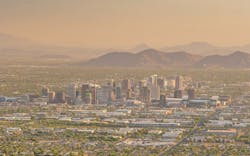Climate Cooling Technologies Put to the Test Against Deadly Phoenix Temperatures
In 2020, extreme heat accounted for nearly 200 deaths in Phoenix during its hottest summer on record with 53 days topping 110°F, according to The Guardian. Arizona’s sunny capital is known for its scorching temperatures during the summer months, but global warming is making the southern city nearly uninhabitable for its 1.4 million residents.
To combat rising temperatures in the coming years, Phoenix’s heat response and mitigation office is implementing immediate and long-term strategies to keep residents safe and to cool the city. By improving access to designated cooling centers, redesigning the region’s heat-trapping concrete, and adding hydration stations, city officials hope to cut down on the risks associated with deadly heat waves, but according to program director David Hondula, some resident populations are more marginalized than others.
Hondula will lead a four-person team with two broad goals: protecting residents when it’s very hot (the heat response part), and coming up with long-term strategies to cool the city and make it more comfortable (the mitigation part). Both require better data, better coordination across government, and money.
But it will take much broader changes to tackle the root causes driving deaths in the most vulnerable group: middle-aged men experiencing homelessness and substance misuse problems. “To reduce deaths, we need to be thinking way upstream and take steps to ease the housing affordability crisis and improve access to substance abuse and recovery services.”
